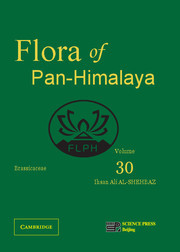Brassicaceae Flora of the Pan-Himalaya Series
Langue : Anglais
Coordonnateur : Al-Shehbaz Ihsan Ali

Volume 30 covers the mustard family (Brassicaceae or Cruciferae), including the new species Lepidium densipuberulum and Sisymbrium nepalense, and the new name L. cuneiforme.
Volume 30 of the Flora of Pan-Himalaya is devoted to the mustard family (Brassicaceae or Cruciferae). The Brassicaceae is one of the most natural plant families, and it is distributed on all continents except Antarctica, though mainly in the temperate, alpine, and subarctic areas. The highest diversity of the family is in the Irano-Turanian region, followed by western North America, the Mediterranean region, the Andes of South America, and the Himalayan region. The nomenclatural novelties in this volume include the new species Lepidium densipuberulum and Sisymbrium nepalense, and the new name L. cuneiforme. Furthermore, the lectotypes of Aphragmus tibeticus, A. stewartii, Braya rubicundula, Cardamine calcicola, C. impatiens var. elongata, C. weixiensis, Draba lichiangensis, Eutrema deltoideum var. grandiflorum, E. przewalskii, E. sherriffii, Hemilophia serpens, Noccaea cochlearioides, Parrya chitralensis, Pyconplinthus uniflora, Solms-laubachia minor, and S.-L. xerophyta are newly designated.
Foreword; Introduction; Preface; Acknowledgements; Part I. Brassicaceae: 1. Alyssum; 2. Calymmatium; 3. Olimarabidopsis; 4. Notoceras; 5. Matthiola; 6. Aphragmus; 7. Acirostrum; 8. Arabis; 9. Arcyosperma; 10. Baimashania; 11. Dendroarabis; 12. Draba; 13. Parryodes; 14. Scapiarabis; 15. Sinoarabis; 16. Megadenia; 17. Brassica; 18. Crambe; 19. Diplotaxis; 20. Eruca; 21. Raphanus; 22. Rapistrum; 23. Sinapis; 24. Goldbachia; 25. Arabidopsis; 26. Camelina; 27. Capsella; 28. Catolobus; 29. Neslia; 30. Barbarea; 31. Cardamine; 32. Nasturtium; 33. Rorippa; 34. Chorispora; 35. Litwinowia; 36. Parrya; 37. Noccaea; 38. Conringia; 39. Crucihimalaya; 40. Ladakiella; 41. Descurainia; 42. Hornungia; 43. Ianhedgea; 44. Dontostemon; 45. Erysimum; 46. Atelanthera; 47. Braya; 48. Christolea; 49. Dilophia; 50. Euclidium; 51. Leiospora; 52. Lepidostemon; 53. Neotorularia; 54. Pycnoplinthopsis; 55. Pycnoplinthus; 56. Shangrilaia; 57. Sisymbriopsis; 58. Solms-Laubachia; 59. Strigosella; 60. Tetracme; 61. Eutrema; 62. Pegaeophyton; 63. Isatis; 64. Lepidium; 65. Megacarpaea; 66. Shehbazia; 67. Sisymbrium; 68. Smelowskia; 69. Stevenia; 70. Alliaria; 71. Didymophysa; 72. Graellsia; 73. Pseudocamelina; 74. Thlaspi; 75. Turritis; 76. Yinshania; 77. Asperuginoides; 78. Dipoma; 79. Hemilophia; General references; Index to scientific names.
Ihsan Ali Al-Shehbaz is a professor at the University of Missouri, St Louis.
Date de parution : 07-2016
Ouvrage de 612 p.
19.1x26.7 cm
Disponible chez l'éditeur (délai d'approvisionnement : 14 jours).
Prix indicatif 185,59 €
Ajouter au panierThème de Brassicaceae :
© 2024 LAVOISIER S.A.S.
